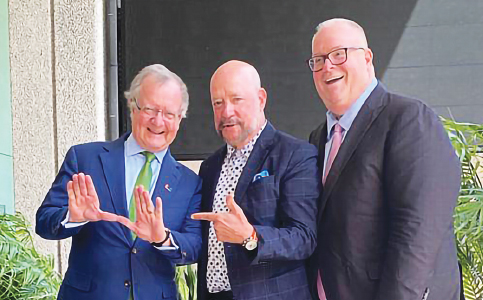Despite gaps, Miami tourism booms to set records

The visitor industry is roaring back in Miami post-covid, but with big changes from two years ago – and two components still remain largely absent, the man at the focal point of tourism growth told Coral Gables Chamber of Commerce members and University of Miami students last week.
“The great news is after covid and all the cancellations… for nine of the last 13 weeks demand has been up not only over [the covid period] but over our best of times in 2019 in terms of heads and beds,” said David Whitaker, CEO of the Greater Miami Convention & Visitors Bureau. “The [average daily room rate] is almost 30% higher than 2½ years ago” and Miami’s is highest in the nation.
This year’s average daily room rate in Miami-Dade County from March 13-19 was $358.95, up from $250.70 in pre-pandemic 2019, according to independent STR research. Revenue per available room averaged $306.49, up from $213.53 in the same week of 2019. Occupancy for that week in the county was 87.8% versus 85.2% in 2019.
Nationally, the industry is also gaining. STR put the average national average daily rate at $151.63 from March 13-19, second highest ever. The national 66.9% occupancy was second highest on record, and revenue per available room of $101.44 was up 9.5% from the prior week.
“These are the best of times in some regard,” Mr. Whitaker told about 150 persons at the Miami Herbert Business School, but “we are still ready for our international visitors to return.”
The international gap remains serious. Just before the pandemic, 49% of all Miami International Airport passengers took international flights. In the fiscal year ended in September 2019, the airport logged 11,447,444 international arrivals and 11,004,277 international departures of 45,811,583 total fliers. But in January, the most recent figures, international traffic was a tick under 40%.
“We can’t just count on all these visitors” who are now producing high numbers of heads in beds, Mr. Whitaker said. Beyond the missing international visitors, “We still have not seen the big group conventions. We need those as well to say that we are truly back.”
The Greater Miami Convention & Visitors Bureau, which Mr. Whitaker rejoined as top executive last August after a gap while he led the visitor marketing of Toronto and then Chicago, has long put a major share of its efforts into booking conventions for the Miami Beach Convention Center and other venues.
Miami Herbert Dean John Quelch, event host and co-moderator, asked Mr. Whitaker whether, considering Zoom meetings and other covid habit changes, conventions will ever regain strength.
Mr. Whitaker noted that remote meetings are at least a decade old, and there has long been fear that they would diminish large business meetings. But “it’s hard to experience your product virtually,” he said. It still must be felt and experienced.
Still, he noted, “remote working is not going to go away…. Covid-19 has made everyone aware of alternatives. We’re not in a cookie-cutter business. Technology is changing how we deal with visitors.”
Also changed beyond recognition, he replied to a question by Jorge Martinez of Florida Blue, is the family travel sector, which once was a pillar of the visitor industry.
Some 25 or 40 years ago, Mr. Whitaker said, a family piled into a station wagon and drove to a place. Now the family unit is very different, as is family travel, he said. With many single parents, or families with two husbands, or older couples with young children, he said, destinations need to appeal to a broader kind of family.
The focus is also different because children start schools younger than 25 years ago. Destinations, he said, now want to be able to expose children to new environments, perhaps featuring art or music, and give them new experiences.
A sense of destination is part of the sell, he said, and in Miami parts of the destination are constantly reinvention themselves – including areas that never were considered a destination before. “When I left here 15 years ago Wynwood didn’t even exist. You wouldn’t ever go to Wynwood…. Doral used to be where you’d go to buy tile.”
Co-moderator Mark Trowbridge, president and CEO of the Coral Gables Chamber, asked what the hospitality industry here is doing for foodies.
Citing the influences of Afro, Cuban, Caribbean and other cuisines, Mr. Whitaker said “this is a food city and a food region.”
He noted that a Michelin guide on food in the region is soon to be announced. When Michelin unveiled the effort last November, it said the Michelin Guide to Florida would cover restaurants in Miami, Orlando and Tampa, the industry’s fifth US dining guide. It was reported independently that Visit Florida would pay $150,000 a year for three years to subsidize the guide and Visit Orlando was paying $116,000 a year for its share, with the Greater Miami Convention & Visitors Bureau and Visit Tampa paying about the same annually.
Another change in Miami since Mr. Whitaker first worked at the bureau was the nature of the people coming here for shopping. After standing 45 minutes at the valet stand at the Bal Harbour Shops watching the flow of high-end autos, he said, “I’m stunned by the opulence.”







Recent Comments